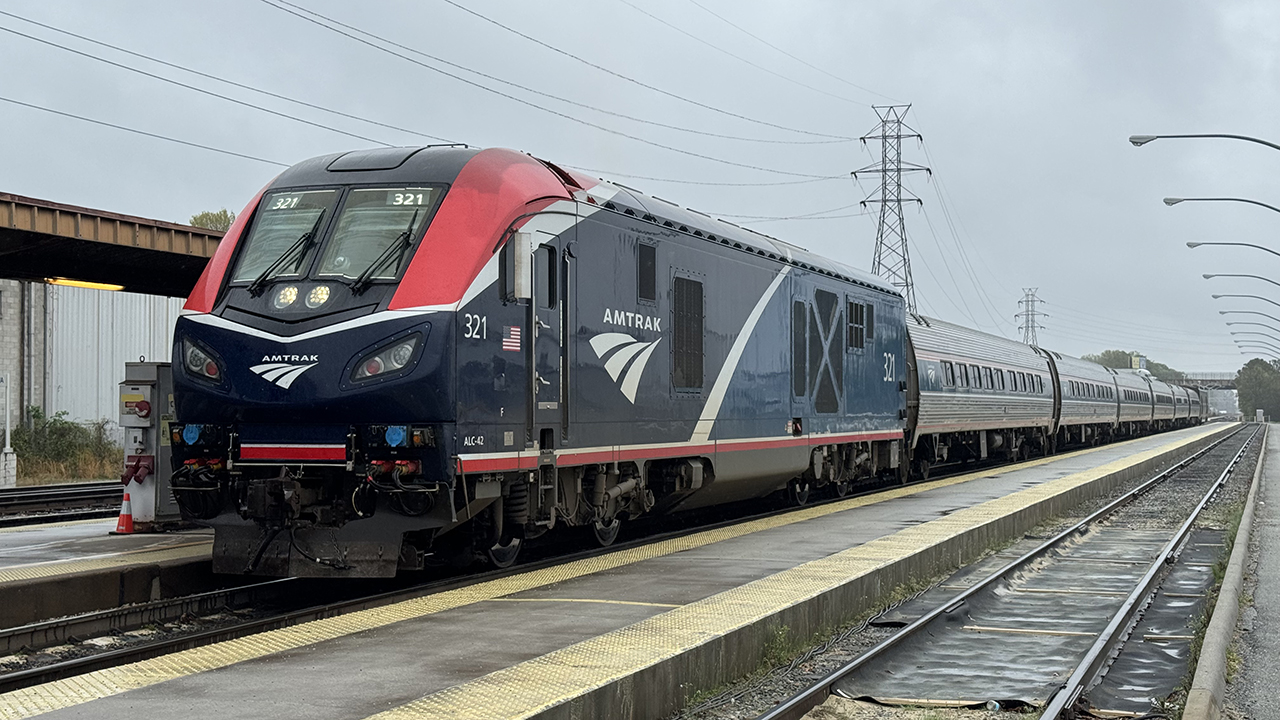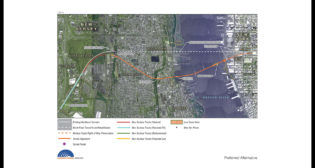
RUN Conference Tackling L-D Trains
Written by David Peter Alan, Contributing Editor
Amtrak Siemens Mobility-built ALC42 321, pulling Train 90, the northbound Palmetto, at Richmond, Va. William C. Vantuono photo.
Amtrak’s skeletal network of long-distance (L-D) passenger trains is the same size now as it was in 1971, when “America’s Railroad” was founded—14 routes. Advocates around the nation are pushing for that network to grow. They hope that, at long last, there will be more L-D passenger trains on the rails than at any time prior to 1979, when Amtrak discontinued six of its L-D routes. The Rail Users’ Network (RUN), a national organization that advocates for improvements on Amtrak, more rail transit and better connectivity between them, will hold an on-line conference on the subject on Friday, May 17, from 12:30 until 5:00 PM EDT time via Zoom.
The theme of the conference will be Expanding Long-Distance Rail Service. Why Amtrak Service to More Towns and Cities is Important to the Entire U.S.! RUN Chair Richard Rudolph will kick off the event. He told me, “We’re excited that the Federal Railroad Administration is in the process of conducting studies that could restore or develop 15 different routes across the United States, but we have doubts about whether this will actually happen in our lifetimes. Nevertheless, it’s important to highlight what’s actually happening, and we’re excited about the idea that passenger rail might return to places like Montana. We’re also excited about the possibility of restoring daily service on the Cardinal and the Sunset Limited. Whether or not any of these things happen will probably depend on the election this November.”
The conference will take place amid newly revived efforts to expand the nation’s network of L-D trains, highlighted by an ongoing FRA study on which Railway Age reported and I commented. In that study, the agency said that three potential improvements could be implemented sooner than the other suggested routes: daily operation on the Cardinal and the Sunset Limited (both have operated on tri-weekly schedules for decades), and restoration of passenger service on the historic Northern Pacific Railroad’s main, the train that was historically called the North Coast Limited. Amtrak called it the North Coast Hiawatha during the 1970s, until it was discontinued in 1979.
Todd Liebman, President of All Aboard Arizona, that state’s advocacy organization, will give an update on the campaign for daily service on the Sunset. Huntington, W.Va. Mayor Steve Williams will do the same for the Cardinal campaign. David Strohmaier, Chair of the Big Sky Passenger Rail Authority and a County Commissioner in Missoula, Mont., will give a presentation on the effort that his organization is leading to restore a train on the North Coast route.
The program will also include presentations about other potential routes suggested in the FRA study, but on a significantly longer planning frontier. Mike Christensen, Executive Director of the Utah Rail Passenger Association, will discuss the effort to restore the Pioneer, a train between the Northwest and Denver that ran on Union Pacific rails from 1979 to 1997. Knox Ross, Chair of the Southern Rail Commission, has been known recently for his efforts toward restoring Gulf Coast service between New Orleans and Mobile, but he is also involved with an initiative to run a train between Meridian, Miss. and Dallas. It would connect at Meridian with Amtrak’s Crescent between New Orleans and New York, and was proposed more than 20 years ago by John Robert Smith, who was Chair of the Amtrak Board at the time. J.W. Madison, President of Rails, Inc. in New Mexico, will describe that organization’s efforts to establish the proposed Rocky Mountain Flyer between El Paso and Montana, through New Mexico, Colorado and Wyoming. That route is also on the FRA’s list of suggestions.
L-D service on Amtrak has become problematic, as the Superliner equipment used on western trains and the Capitol Limited, as well as the Amfleet II cars used on trains in the East, are now approaching 40 years of age, and some are older. Amtrak is talking about purchasing new equipment to replace them, and Frederico Gazzolo, Amtrak’s Vice President for Product Development and Customer Analytics, will discuss the railroad’s efforts to procure such equipment.
While the most recently added L-D train running today is the Capitol Limited, which was revived in 1985, there have been some more-successful efforts to bring back shorter-distance routes. Ken Buehler, Executive Director of the Lake Superior Railroad Museum in Duluth, will talk about efforts to restore service between that city and at least one of Minnesota’s Twin Cities.
The conference will include two panels. One will focus on restoring components of a re-routed version of the Floridian route between Chicago and Miami, which was discontinued in 1979. The revived train would run through Chattanooga and Atlanta. Officials from Louisville, Chattanooga and the Georgia DOT will report on their efforts, with RUN Chair Richard Rudolph as moderator.
The other panel will not focus on advocacy efforts, but on a “skills and methods” approach to the steps required to get a new train up and running, including equipment and relationships with host railroads. RUN Vice Chair Andrew Albert will moderate the panel, which will consist of three railroaders who each have a half-century or more of experience in railroading. They include RUN Board members Phil Streby, an Amtrak retiree who also obtained railroad experience in the Army Transportation Corps, and Joshua Coran, who served as Director of Product Development and Compliance at Talgo. The third member will be Jim Blaze, a railroad economist who is also a Railway Age Contributing Editor. I will deliver the closing remarks.
Registration is still open, and anyone interested can register on the www.railusers.net, the RUN website. Click on “Register Now!” A description of the conference is also available on the site. RUN says, “The conference is designed not only for rail advocates, but also for civic and business leaders, environmentalists, planners, real estate developers and members of the general public who are interested in knowing more about passenger rail and rail transit in America.”
There is no charge for RUN members to attend the conference, and the fee for non-members is $25.00. As a bonus for non-members, that amount will include a RUN membership for the rest of the year as an “introductory” member.
For conference attendees in the New York/New Jersey area, there will be a walking tour of stations in New Jersey and New York City where New Jersey Transit’s rail services connect. The event will take place on Saturday, May 18 and will also include a look at Penn Station and both the historic Grand Central Terminal and the Long Island Rail Road’s Grand Central Madison station. There is more information about that event on the Lackawanna Coalition website. There is no charge for the tour itself, but participants must pay applicable fares.
The advocates at RUN hope the conference will bring participants up to date on efforts to expand America’s L-D network of passenger trains and help the traveling public reach more destinations by train. I will report the results of the conference.



